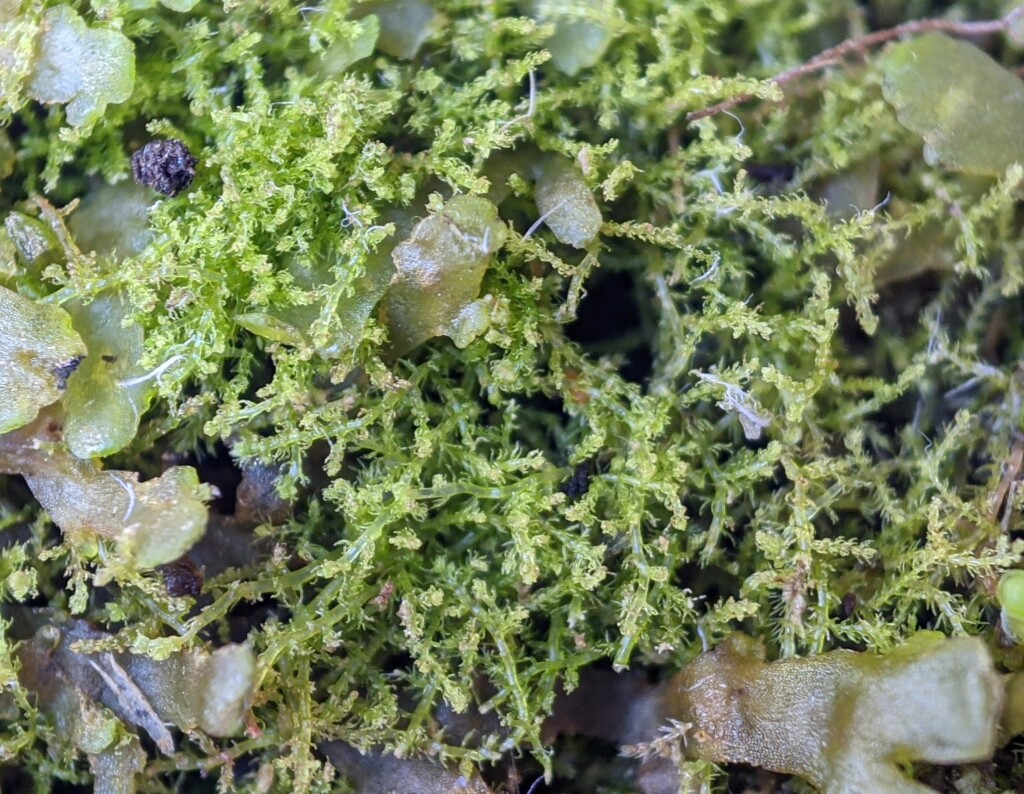Kurzia
Terrestrial, dioecious. Asexual reproduction by caducous leaf lobes (not in Victoria). Stems creeping to erect, regularly 1–3-pinnate, or rarely irregularly branched (not in Victoria), with two ranks of lateral leaves and a single rank of underleaves; branches development variable, usually without a collar of tissue at base and emerging from stem abaxial to a lateral leaf with fewer lobes on one side of the stem, alternating with branches emerging from stem adaxial to a lateral leaf with fewer lobes on the other side of the stem, rarely with one condition prevalent over the other and not regularly alternating between conditions (not in Victoria), sometimes leafy (not in Victoria) or leafless branches emerging from abaxial stem and with a collar of tissue at base, rarely branches emerging laterally from stem and with a collar of tissue at base (not in Victoria), or rarely emerging from beside an underleaf with fewer lobes (not in Victoria) and without a collar of tissue at base. Lateral leaves deeply divided, sometimes to near base, into 2–6 lobes, semicircular to cuneate in outline, hand-like, transverse to succubous (not in Victoria), rarely weakly incubous (not in Victoria), erect- to widely spreading, distant to imbricate, entire or dentate, collectively whitish, light to dark or olive green or brownish, unistratose; lobes equal or unequal, narrowly triangular and several cells wide at base to setaceous and completely uniseriate, acute, entire. Underleaves subequal to lateral leaves to much smaller than lateral leaves, 2–4-lobed, distant to imbricate; lobes narrowly triangular to setaceous, sometimes ending in a slime papilla. Leaf cells quadrate, polygonal or oblong, sometimes more elongate and rectangular in lobes, papillose, rarely smooth, firm- or thick-walled, without trigones, without or with 1–2 ovoid to fusiform and homogenous to few-segmented oil bodies. Androecia short branches rising from abaxial stem, comprising 2–8 pairs of leaf-like bracts, each with a single antheridium. Sporophytes at apex of branches arising from abaxial stem, subtended by several series of bracts; bracts becoming much larger and less deeply divided than leaves, laciniate (not in Victoria) to ciliate. Perianth enormous relative to size of plant, cylindric, terete at base becoming trigonous toward mouth; mouth ciliate-laciniate. Capsule ellipsoid, 2–4-stratose; elaters bispiral. Spores spherical, verruculose or papillose.
Forty-seven species, mostly from southern temperate regions, but also extending to Japan and the Himalayas, Central America and the Caribbean, and four species widespread in cool regions of the Northern Hemisphere (Schuster 2000; Söderström et al. 2016); four species in Victoria.
Schuster, R.M. (2000). Austral Hepaticae Part I. Nova Hedwigia Beiheft 118. Cramer in der Gebrüder Borntraeger Verlagsbuchbehandlung: Berling & Stuttgart.
Söderström, L., Hagborg, A., von Konrat, M., Bartholomew-Began, S., Bell, D., Briscoe, L., Brown, E., Cargill, D.C., Costa, D.P., Crandall-Stotler, B.J., Cooper, E.D., Dauphin, G., Engel, J.J., Feldberg, K., Glenny, D., Gradstein, S.R., He, X., Heinrichs, J., Hentschel, J., Ilkiu-Borges, A.L., Katagiri, T., Konstantinova, N.A., Larraín, J., Long, D.G., Nebel, M., Pócs, T., Puche, F., Reiner-Drehwald, E., Renner, M.A.M., Sass-Gyarmati, A., Schäfer-Verwimp, A., Moragues, J.S., Stotler, R.E., Sukkharak, P., Thiers, B.M., Uribe, J., Váňa, J., Villarreal, J.C., Wigginton, M., Zhang, L. & Zhu, R. (2016). World checklist of hornworts and liverworts. Phytokeys 59: 1–828.
 Spinning
Spinning